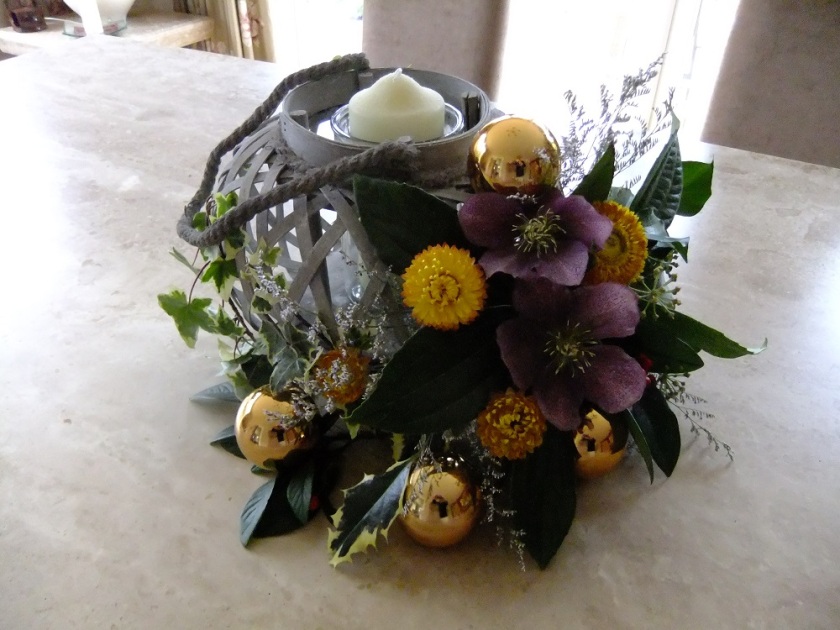The fact that so few herbaceous plants are winter flowering makes the show of Helleborus orientalis around the Honey Pot Flowers garden particularly special at this time of year. With large flowers from dark aubergine through shades of pink to white, these flowers make you stop as you wander around the winter garden turning over the downward facing flowers to look at the exquisite markings on the ‘petals’.
Hellebores do not have petals in the normal sense of the word as their petals are really sepals (modified leaves that typically protect the flower bud).
Cultivation
To be honest once Hellebores have established they are very undemanding herbaceous perennials. They like areas of part-shade in our garden and seed themselves freely. When mature the plants do not like to be disturbed but careful transplanting of the seedlings (digging them up with soil so as to not expose the roots) allows you to distribute them throughout the garden.
You can also propagate larger plants by division in early spring if you have a particularly beautiful specimen that you want to bulk up. Your self-sown seedlings are unlikely to come true to colour (but half the fun is seeing how they will develop).
To show off the flowers at their best in the garden we usually remove the sad, dying leaves at soil level in January to expose the flowers. As well as exposing the flowers this helps reduce the spread of disease. The fresh new leaves will grow back again during the spring and look great throughout the summer.

Cutting and conditioning
With so few flowers around in the early months of the year, Hellebores are very valuable for winter arrangements. Because the flowers face downwards their full beauty may not be evident. For dinner table, coffee and side table arrangements simply taking the flowers and floating them in water face up in a clear crystal glass bowl can make a stunning display showing off all the varied colours and delicate markings.

It has to be said that many people find the conditioning of Hellebores a challenge. There seem to be a range of views on how this is best done.
Armitage and Lushman in “Speciality Cut Flowers” indicate that you can achieve 10-14 days in the vase. Stage of harvest seems to be particularly critical and they suggest for fresh flowers Hellebores should be cut when the stamens first become visible. For drying, flowers can be cut at anytime but particularly when the seed capsules become visible.
Sarah Raven in “The Cutting Garden” advocates putting the bottom inch of the stem in boiling water for 20 seconds and then plunging it into deep tepid water. With this treatment she indicates that the stems will stay fresh for 3 or 4 days (considerably less however than the vase life offered in Armitage and Lushman).
There also seems to be contradictory advice on the use of “flower food”. Comments from commercial growers in Armitage and Lushman indicate that “they have a wonderful long vase life, 10 days plus easy, and I give no special treatment other than Floralife”. In contrast Linda Beutler in “Garden to Vase” indicates that Hellesbore blooms do not tolerate floral preservative.
Most references indicate that Hellesbores do not last well in floral foam.
Our experience of using Hellesbores as cut flowers is that they are unpredictable. We have had most success when we have delayed cutting the flowers until the seed pods begin to develop. Cutting at this point the flowers are much more reliable and hold up well. Floret Farm’s “Cut Flower Garden” also recommends this approach and indicates that the flowers will last about 5-8 days in the vase.
It can be argued that using Hellesbores in ‘high stakes’ arrangements can be (is) risky. However, they are such charming flowers at a time of year when there is very little and it is well worth practising to perfect your conditioning technique.

Drying
As well as offering fresh cut stems, Hellebore flowers also dry well and can be used in buttonholes, corsages or wreaths. Gently covered with silica gel they will dry within 2 weeks and can then be stored in an air tight plastic box. They keep their colour well if kept in the dark and can be kept right through to the following Christmas to bring a different touch to Christmas wreaths.
Don’t be tempted to over dry them by leaving them in the silica gel for too long. They will simply suck up moisture when the are removed and will spoil quickly.

Other species in the garden
The majority of the Hellebores in the Waverley garden are Helleborus orientalis but we do also have occasional plants of the stinking Hellebore Helleborus foetidus. H. foetidus has smaller hanging bell shaped flowers on a tall stem that make a very useful fresh green addition to winter arrangements.
Hardy perennial
Origin: Greece and Turkey (ref: Wikipedia)
Family: Ranunculaceae
Hardiness: H7 (RHS hardiness rating – Hardy in the severest European continental climates (< -20)
Height: 40-45 cm
Flowering period: January to March
Derivation of scientific name: According to Wikipedia and Witchipedia, the genus name Helleborus comes from the ancient Greek word elein, meaning “to injure” and bora, meaning “food”.
Toxicity: Poisonous
Floriography: Slander and scandal
References:
“The Cutting Garden” by Sarah Raven (ISBN 978-0-7112-3465-9)
“Specialty cut flowers” by Armitage and Lushman (ISBN 0-88192-579-9)
“Garden to Vase” by Linda Beutler (ISBN 978-0-88192-825-9)
“Cut Flower Garden” by Erin Benzakein and Julie Chai (ISBN 978-1-4521-4576-1)

7 thoughts on “Helleborus orientalis (Lenten Rose)”